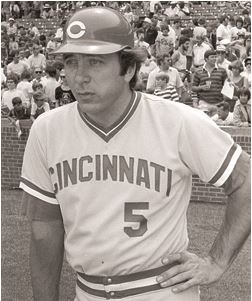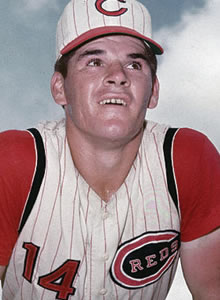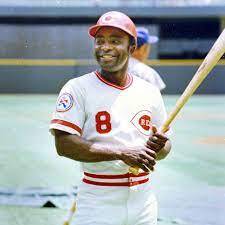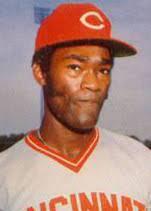|
| Famous Players |
Johnny Bench:
 Making his major league debut in 1967 at the age of 19, he would go on to play his entire 17-year big league career (1967-83) with the Reds, rewriting the standards for catchers.As the leader of Cincinnati’s Big Red Machine of the 1970s, in which he helped the franchise to four National League pennants and two World Series titles, the rugged and durable Bench was a 10-time Gold Glove Award winner as the result of his skilled handling of pitchers, unparalleled defensive skills and a lightning quick throwing arm that would intimidate would-be base runners. He led the NL in caught stealing percentage three times and putouts twice.Bench also provided a potent bat, hitting 389 home runs and leading the league in RBI three times and homers twice. Highly honored during his career, Bench won the 1968 NL Rookie of the Year, was a two-time NL MVP (1970 and 1972) and 14-time All-Star. He won the 1976 World Series MVP Award as the Reds completed their back-to-back run of titles. Bench was elected to the Hall of Fame in 1989. Making his major league debut in 1967 at the age of 19, he would go on to play his entire 17-year big league career (1967-83) with the Reds, rewriting the standards for catchers.As the leader of Cincinnati’s Big Red Machine of the 1970s, in which he helped the franchise to four National League pennants and two World Series titles, the rugged and durable Bench was a 10-time Gold Glove Award winner as the result of his skilled handling of pitchers, unparalleled defensive skills and a lightning quick throwing arm that would intimidate would-be base runners. He led the NL in caught stealing percentage three times and putouts twice.Bench also provided a potent bat, hitting 389 home runs and leading the league in RBI three times and homers twice. Highly honored during his career, Bench won the 1968 NL Rookie of the Year, was a two-time NL MVP (1970 and 1972) and 14-time All-Star. He won the 1976 World Series MVP Award as the Reds completed their back-to-back run of titles. Bench was elected to the Hall of Fame in 1989.
|
Pete Rose:
Rose was a switch hitter and is the all-time MLB leader in hits (4,256), games played (3,562), at-bats (14,053), singles (3,215), and outs (10,328). He won three World Series, three batting titles, one Most Valuable Player Award, two Gold Gloves, and the Rookie of the  Year Award, and also made 17 All-Star appearances at an unequaled five positions (second baseman, left fielder, right fielder, third baseman, and first baseman). Rose won both of his Gold Gloves when he was an outfielder, in 1969 and 1970.Rose was a significant factor in the Reds' success in 1975 and 1976 when he successfully moved from the outfield to third base. Earlier in his career, the Reds and then-manager Don Heffner tried to force Rose to third base, but Rose chafed at the move and it was soon abandoned. In the spring of 1975, manager Sparky Anderson, knowing how Rose would react to being forced to move, instead asked him if he would do so for the good of the team. Rose immediately agreed. This move strengthened third base and helped to solidify the Reds team for those two championship seasons, because it made room for power hitting outfielder George Foster. In 1975, Rose earned World Series MVP honors in leading the Reds to their first championship since 1940, a seven-game triumph over the Boston Red Sox. Rose led the team with 10 hits and a .370 batting average in the seven games. He was awarded the Hickok Belt as the top professional athlete of the year, as well as Sports Illustrated magazine's "Sportsman of the Year" award. Year Award, and also made 17 All-Star appearances at an unequaled five positions (second baseman, left fielder, right fielder, third baseman, and first baseman). Rose won both of his Gold Gloves when he was an outfielder, in 1969 and 1970.Rose was a significant factor in the Reds' success in 1975 and 1976 when he successfully moved from the outfield to third base. Earlier in his career, the Reds and then-manager Don Heffner tried to force Rose to third base, but Rose chafed at the move and it was soon abandoned. In the spring of 1975, manager Sparky Anderson, knowing how Rose would react to being forced to move, instead asked him if he would do so for the good of the team. Rose immediately agreed. This move strengthened third base and helped to solidify the Reds team for those two championship seasons, because it made room for power hitting outfielder George Foster. In 1975, Rose earned World Series MVP honors in leading the Reds to their first championship since 1940, a seven-game triumph over the Boston Red Sox. Rose led the team with 10 hits and a .370 batting average in the seven games. He was awarded the Hickok Belt as the top professional athlete of the year, as well as Sports Illustrated magazine's "Sportsman of the Year" award. |
Joe Morgan:
Comparable in size to early 20th century players at 5-foot-7, 160 pounds, Joe Morgan instead was perfectly suited to the artificial surface game of the 1970s, when he emerged as one of the  key cogs in Cincinnati’s Big Red Machine. In the Reds’ back-to-back World Series championship years in 1975-76, Morgan won back-to-back MVP awards in the National League, as well as two of his five consecutive Gold Glove Awards. He spent nine seasons with Houston and made two All-Star Game appearances, but became a Hall of Famer after being traded in November 1971 to the Reds and leaving Houston’s cavernous Astrodome.Morgan led the league in walks, on-base percentage and runs scored in his first season with Cincinnati and earned All-Star Game nods in each of his eight seasons with the Reds. In his peak years of 1975 and ’76, he twice led all of baseball in OPS. Morgan finished his career with 2,517 hits, 1,650 runs scored, 268 home runs, 689 stolen bases and 1,865 walks. Morgan was elected to the Hall of Fame in 1990. He passed away on Oct. 11, 2020. key cogs in Cincinnati’s Big Red Machine. In the Reds’ back-to-back World Series championship years in 1975-76, Morgan won back-to-back MVP awards in the National League, as well as two of his five consecutive Gold Glove Awards. He spent nine seasons with Houston and made two All-Star Game appearances, but became a Hall of Famer after being traded in November 1971 to the Reds and leaving Houston’s cavernous Astrodome.Morgan led the league in walks, on-base percentage and runs scored in his first season with Cincinnati and earned All-Star Game nods in each of his eight seasons with the Reds. In his peak years of 1975 and ’76, he twice led all of baseball in OPS. Morgan finished his career with 2,517 hits, 1,650 runs scored, 268 home runs, 689 stolen bases and 1,865 walks. Morgan was elected to the Hall of Fame in 1990. He passed away on Oct. 11, 2020. |
George Foster:
 He played in Major League Baseball as an outfielder from 1969 through 1986, most notably as an integral member of the Cincinnati Reds dynasty that won four National League pennants and two World Series championships between 1970 and 1976.A five-time All-Star, Foster was one of the most feared right-handed sluggers of his era, leading the National League in home runs in 1977 and 1978, and in RBIs in 1976, 1977, and 1978. He won the National League's Most Valuable Player Award in 1977 and a Silver Slugger Award in 1981. In 2003, Foster was inducted into the Cincinnati Reds Hall of Fame.Early in the 1975 season, Reds manager Sparky Anderson shifted perennial All-Star Pete Rose to third base, and used a platoon of Foster and Dan Driessen in left. Foster soon won the everyday job with a .300 batting average, 23 home runs and 78 RBIs. With Foster now in left, the final piece of the "Big Red Machine" was in place. The Reds won 108 games that year, tying the 1970 World Series champion Baltimore Orioles for the most regular season wins that decade. They dominated the Pirates in the 1975 National League Championship Series, out-scoring their opponent 19–7 to sweep the series in three games. For his part, Foster batted .364 and scored three runs.In 1977 games over 18 seasons, Foster compiled a .274 batting average (1925-for-7023) with 986 runs, 307 doubles, 47 triples, 348 home runs, 1239 RBI, 666 walks, 1419 strikeouts, a .338 on-base percentage and a .480 slugging percentage. He posted a .984 fielding percentage at all three outfield positions. In 23 post-season games (3 World Series, 4 NLCS), he hit .289 (22-for-76) with 11 runs, 2 doubles, 3 home runs, 12 RBI and 8 walks. He played in Major League Baseball as an outfielder from 1969 through 1986, most notably as an integral member of the Cincinnati Reds dynasty that won four National League pennants and two World Series championships between 1970 and 1976.A five-time All-Star, Foster was one of the most feared right-handed sluggers of his era, leading the National League in home runs in 1977 and 1978, and in RBIs in 1976, 1977, and 1978. He won the National League's Most Valuable Player Award in 1977 and a Silver Slugger Award in 1981. In 2003, Foster was inducted into the Cincinnati Reds Hall of Fame.Early in the 1975 season, Reds manager Sparky Anderson shifted perennial All-Star Pete Rose to third base, and used a platoon of Foster and Dan Driessen in left. Foster soon won the everyday job with a .300 batting average, 23 home runs and 78 RBIs. With Foster now in left, the final piece of the "Big Red Machine" was in place. The Reds won 108 games that year, tying the 1970 World Series champion Baltimore Orioles for the most regular season wins that decade. They dominated the Pirates in the 1975 National League Championship Series, out-scoring their opponent 19–7 to sweep the series in three games. For his part, Foster batted .364 and scored three runs.In 1977 games over 18 seasons, Foster compiled a .274 batting average (1925-for-7023) with 986 runs, 307 doubles, 47 triples, 348 home runs, 1239 RBI, 666 walks, 1419 strikeouts, a .338 on-base percentage and a .480 slugging percentage. He posted a .984 fielding percentage at all three outfield positions. In 23 post-season games (3 World Series, 4 NLCS), he hit .289 (22-for-76) with 11 runs, 2 doubles, 3 home runs, 12 RBI and 8 walks. |
|

 Making his major league debut in 1967 at the age of 19, he would go on to play his entire 17-year big league career (1967-83) with the Reds, rewriting the standards for catchers.As the leader of Cincinnati’s Big Red Machine of the 1970s, in which he helped the franchise to four National League pennants and two World Series titles, the rugged and durable Bench was a 10-time Gold Glove Award winner as the result of his skilled handling of pitchers, unparalleled defensive skills and a lightning quick throwing arm that would intimidate would-be base runners. He led the NL in caught stealing percentage three times and putouts twice.Bench also provided a potent bat, hitting 389 home runs and leading the league in RBI three times and homers twice. Highly honored during his career, Bench won the 1968 NL Rookie of the Year, was a two-time NL MVP (1970 and 1972) and 14-time All-Star. He won the 1976 World Series MVP Award as the Reds completed their back-to-back run of titles. Bench was elected to the Hall of Fame in 1989.
Making his major league debut in 1967 at the age of 19, he would go on to play his entire 17-year big league career (1967-83) with the Reds, rewriting the standards for catchers.As the leader of Cincinnati’s Big Red Machine of the 1970s, in which he helped the franchise to four National League pennants and two World Series titles, the rugged and durable Bench was a 10-time Gold Glove Award winner as the result of his skilled handling of pitchers, unparalleled defensive skills and a lightning quick throwing arm that would intimidate would-be base runners. He led the NL in caught stealing percentage three times and putouts twice.Bench also provided a potent bat, hitting 389 home runs and leading the league in RBI three times and homers twice. Highly honored during his career, Bench won the 1968 NL Rookie of the Year, was a two-time NL MVP (1970 and 1972) and 14-time All-Star. He won the 1976 World Series MVP Award as the Reds completed their back-to-back run of titles. Bench was elected to the Hall of Fame in 1989. Year Award
Year Award key cogs in Cincinnati’s Big Red Machine. In the Reds’ back-to-back World Series championship years in 1975-76, Morgan won back-to-back MVP awards in the National League, as well as two of his five consecutive Gold Glove Awards. He spent nine seasons with Houston and made two All-Star Game appearances, but became a Hall of Famer after being traded in November 1971 to the Reds and leaving Houston’s cavernous Astrodome.Morgan led the league in walks, on-base percentage and runs scored in his first season with Cincinnati and earned All-Star Game nods in each of his eight seasons with the Reds. In his peak years of 1975 and ’76, he twice led all of baseball in OPS. Morgan finished his career with 2,517 hits, 1,650 runs scored, 268 home runs, 689 stolen bases and 1,865 walks. Morgan was elected to the Hall of Fame in 1990. He passed away on Oct. 11, 2020.
key cogs in Cincinnati’s Big Red Machine. In the Reds’ back-to-back World Series championship years in 1975-76, Morgan won back-to-back MVP awards in the National League, as well as two of his five consecutive Gold Glove Awards. He spent nine seasons with Houston and made two All-Star Game appearances, but became a Hall of Famer after being traded in November 1971 to the Reds and leaving Houston’s cavernous Astrodome.Morgan led the league in walks, on-base percentage and runs scored in his first season with Cincinnati and earned All-Star Game nods in each of his eight seasons with the Reds. In his peak years of 1975 and ’76, he twice led all of baseball in OPS. Morgan finished his career with 2,517 hits, 1,650 runs scored, 268 home runs, 689 stolen bases and 1,865 walks. Morgan was elected to the Hall of Fame in 1990. He passed away on Oct. 11, 2020. He played in Major League Baseball as an outfielder from 1969 through 1986, most notably as an integral member of the Cincinnati Reds dynasty that won four National League pennants and two World Series championships between 1970 and 1976.A five-time All-Star, Foster was one of the most feared right-handed sluggers of his era, leading the National League in home runs in 1977 and 1978, and in RBIs in 1976, 1977, and 1978. He won the National League's
He played in Major League Baseball as an outfielder from 1969 through 1986, most notably as an integral member of the Cincinnati Reds dynasty that won four National League pennants and two World Series championships between 1970 and 1976.A five-time All-Star, Foster was one of the most feared right-handed sluggers of his era, leading the National League in home runs in 1977 and 1978, and in RBIs in 1976, 1977, and 1978. He won the National League's